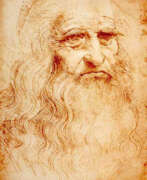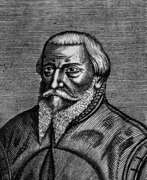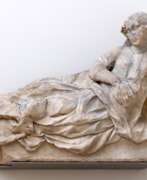Sculptors 15th century


Amico Aspertini was an Italian Renaissance painter, draughtsman, and sculptor, considered one of the leading representatives of the Bolognese school of painting.
He was trained in the family workshop and was influenced by the artists of the Ferrara school, Ercole de'Roberti, Lorenzo Costa, and Francesco Francia. He worked as a painter and sculptor, and was also an excellent draughtsman, as evidenced by his many surviving drawings and sketches. Contemporaries marveled at his complex and impulsive character and noted that he worked with both hands simultaneously.
Aspertini painted splendid portraits as well as numerous frescoes and altarpiece paintings in chapels and churches in Italy. Many of his works are eccentric and eclectic, even whimsically fantastical, his complex style anticipating Mannerism.


Donato di Niccolò di Betto Bardi, better known as Donatello, sculptor of the Renaissance period. Born in Florence, he studied classical sculpture and used this to develop a complete Renaissance style in sculpture. He spent time in other cities, and while there he worked on commissions and taught others; his periods in Rome, Padua, and Siena introduced to other parts of Italy his techniques, developed in the course of a long and productive career. Financed by Cosimo de' Medici, Donatello's David was the first freestanding nude male sculpture since antiquity.
He worked with stone, bronze, wood, clay, stucco, and wax, and had several assistants, with four perhaps being a typical number. Although his best-known works mostly were statues in the round, he developed a new, very shallow, type of bas-relief for small works, and a good deal of his output was larger architectural reliefs.


Gentile Bellini was a seminal Venetian painter, born circa 1429 into Venice’s preeminent family of artists. Known primarily for his portraiture and scenes depicting the Middle East, Bellini's style was marked by precise execution and keen attention to detail. His paintings, especially those from his time in Constantinople, showcased an enchanting blend of Western and Eastern artistic elements, contributing significantly to the Orientalist movement in Western art.
His works are renowned for their incorporation of architectural elements from the regions he visited, which played a pivotal role in educating Europeans about cultures beyond their borders. Bellini served as a cultural ambassador to the Ottoman Court, painting the portrait of Sultan Mehmed II, a work that remains notable for its vivid portrayal and historical significance.
Despite the destruction of many of his paintings, some of Bellini's masterpieces continue to be celebrated, such as "The Miracle of the True Cross at the Bridge of San Lorenzo" and "The Procession in Piazza San Marco," which reflect the grandeur and spirit of Venice during the Renaissance.
Bellini's legacy extends beyond his canvases, influencing the craft and direction of future artists, including his student Titian. While contemporary critics often regard his brother, Giovanni Bellini, as the more accomplished artist, Gentile's contributions to the Venetian school and his role in bridging Western and Eastern art remain undisputed.
For collectors and art experts, Gentile Bellini's work represents a confluence of cultural narratives and artistic excellence. To stay informed about exhibitions and sales featuring Gentile Bellini's work, signing up for updates can provide an exclusive edge in the art and antiques sphere.
If you're interested in exploring Gentile Bellini's works further or considering acquisitions for your collection, don't hesitate to sign up for updates on new product sales and auction events related to this pivotal artist. This service promises a business-like and direct approach to keeping you informed without unnecessary flourish.


Michelangelo di Lodovico Buonarroti Simoni, known simply as Michelangelo, was an Italian sculptor, painter, architect, and poet who played a significant role in the High Renaissance period. Born on March 6, 1475, in Caprese, Italy, Michelangelo's works are a testament to his mastery in various artistic realms, defining him as a quintessential Renaissance man.
Michelangelo's fame began early in his career, most notably with his sculptures "Pietà" (1499) and "David" (1501), both completed before he turned thirty. Despite his self-perception primarily as a sculptor, Michelangelo made an indelible mark in painting, particularly with the frescoes in the Sistine Chapel. These works include the scenes from Genesis on the chapel's ceiling and "The Last Judgment" on its altar wall, showcasing his innovative use of physical realism and psychological tension.
Among his most famous works, the "David" statue, now housed in the Accademia Gallery in Florence, and the "Pietà," located in St. Peter's Basilica, stand out for their intricate detail and emotional depth. Michelangelo's ability to imbue life into marble and his thoughtful consideration of light and shadow in painting were revolutionary. His techniques in fresco painting, such as the buon fresco method used in the Sistine Chapel, where he painted on wet plaster, were groundbreaking for their time.
Despite his temperamental nature, Michelangelo was deeply religious and dedicated to his art, often eschewing the use of assistants. His works were not only recognized and admired in Italy but also attracted attention from abroad, including the Ottoman Empire. Michelangelo's influence extended beyond his lifetime, significantly impacting the development of Mannerism and the Baroque style.
For art collectors and experts, Michelangelo's works remain a pinnacle of artistic achievement. His ability to blend realism with expressive physicality in both sculpture and painting set new standards in art. His works in major museums and galleries worldwide continue to inspire and awe viewers, reflecting the enduring legacy of his genius.
For those interested in the world of art and antiques, staying informed about Michelangelo's works and their influence on modern art is essential. To receive updates on new product sales and auction events related to Michelangelo, sign up for our newsletter. This subscription is an excellent opportunity for enthusiasts and experts alike to stay connected with the ongoing legacy of one of history's greatest artists.


Lorenzo di Credi was an Italian Renaissance painter and sculptor best known for his paintings of religious subjects. He is most famous for having worked in the studio of Andrea del Verrocchio at the same time as the young Leonardo da Vinci.


Leonardo da Vinci was an Italian polymath of the High Renaissance, celebrated as a painter, draughtsman, engineer, scientist, theorist, sculptor, and architect. His remarkable abilities and innovative thinking made him an epitome of the Renaissance humanist ideal. Born in Vinci, near Florence, in 1452, Leonardo was educated in Florence by Andrea del Verrocchio, a renowned painter and sculptor. He began his career in Florence, later working in Milan, Rome, and France, where he died in 1519.
Da Vinci is revered for his artistic mastery, technological innovation, and scientific inquiry. Despite having fewer than 25 major works attributed to him, including several unfinished ones, his influence on Western art is profound. His magnum opus, the "Mona Lisa," housed in the Louvre Museum, Paris, is considered the world's most famous painting. "The Last Supper," his most reproduced religious painting, showcases his mastery of dramatic narrative and pictorial illusionism. Both paintings exhibit Leonardo's unique ability to convey complex human emotions and his innovative use of techniques like sfumato and chiaroscuro.
Leonardo's interests extended far beyond fine art. He was a visionary in multiple fields, including anatomy, physics, architecture, and mechanics. His notebooks reveal designs for machines like bicycles, helicopters, and military tanks, centuries ahead of their time. However, due to his diverse interests, he left many projects and paintings incomplete. Leonardo's final years were spent in France, where he continued his artistic and scientific pursuits until his death.
For collectors and experts in art and antiques, Leonardo da Vinci remains a figure of endless fascination. His works not only embody the pinnacle of Renaissance art but also provide insights into the era's scientific and philosophical inquiry. To stay updated on new sales and auction events related to Leonardo da Vinci, sign up for our newsletter. This subscription is a gateway to exploring the rich legacy of this unparalleled artist and inventor.


Andrea del Verrocchio, a prominent figure of the Italian Renaissance, was a master of multiple disciplines including sculpture, painting, and goldsmithing. Born in Florence around 1435, Verrocchio was a versatile artist whose influence extended far beyond his own creations, most notably as the mentor to Leonardo da Vinci. His works span a range of media, showcasing his expertise in both the sculptural and painterly aspects of Renaissance art.
Verrocchio's studio was a fertile ground for the incubation of Renaissance artistic talent. Among his most celebrated works is the bronze statue of David, commissioned by the Medici, which displays a youthful victor standing over Goliath, emblematic of Florence's civic pride and cultural ambition. This piece, alongside his equestrian statue of Bartolomeo Colleoni in Venice, exemplifies Verrocchio's skill in capturing dynamic figures and his innovative approach to bronze casting.
In painting, Verrocchio's contributions, though fewer in number, are significant for their exploration of depth and perspective, hallmarks of Renaissance artistry. His Baptism of Christ, for example, is notable not only for its own merits but also for Leonardo da Vinci's participation, which, according to legend, led Verrocchio to never paint again, outshone by his pupil's talent. However, this story is often considered apocryphal.
Verrocchio's legacy is cemented by the breadth of his work and the generations of artists he influenced. His adeptness across multiple forms—sculpture, painting, and goldsmithing—places him among the Renaissance's most versatile and influential figures. His sculptures and paintings remain pivotal in understanding the evolution of Renaissance art, characterized by a deep understanding of human anatomy, a mastery over materials, and an innovative approach to traditional themes.
For collectors and experts in art and antiques, Verrocchio's works offer a fascinating insight into the mastery and creativity of the Renaissance period. His influence on subsequent generations of artists underscores the enduring value and appeal of his creations.
For those interested in staying informed about upcoming sales and auction events featuring works by Andrea del Verrocchio, signing up for updates can provide exclusive access to the latest offerings in this realm. This ensures that enthusiasts and collectors alike remain connected to the vibrant market for Renaissance art, celebrating the legacy of one of its most distinguished masters.


Francesco Francia, also known as Francesco Raibolini, was an Italian painter, goldsmith, and medallist from Bologna. He began his career in the late 15th century and collaborated with artists like Lorenzo Costa, drawing inspiration from the styles of Ercole de' Roberti, Perugino, and Raphael.
Francia ran a successful workshop and trained notable artists such as Marcantonio Raimondi and Ludovico Marmitta. While it was once rumored that Raphael's work caused him to die of depression, their friendship has since debunked this claim.
Francesco Francia passed away in Bologna, and his sons, Giacomo Francia and Giulio Francia, also became artists.


Veit Stoß war ein bedeutender deutscher Bildhauer, dessen Werk den Übergang von der Spätgotik zur nördlichen Renaissance markiert. Der um 1450 in der Nähe von Horb am Neckar geborene Stoß ist für seinen gefühlsbetonten Stil und seine filigranen Schnitzereien, vor allem in Holz, bekannt. Sein Hauptwerk, der 1489 vollendete Veit-Stoß-Altar in der Krakauer Marienkirche, ist ein Zeugnis seines handwerklichen Könnens und gilt als eines der größten Triptychen seiner Zeit.
Nach seiner Rückkehr nach Nürnberg im Jahr 1496 geriet Stoß in Turbulenzen, unter anderem wurde er wegen Fälschung verurteilt, aber schließlich begnadigt. Seine späteren Werke, wie der "Tobias und der Engel", zeigen weiterhin sein außergewöhnliches Talent und wurden sogar von Kritikern wie Giorgio Vasari bewundert.
Für alle, die sich für die Kunst der Bildhauerei und die Geschichte der Renaissance interessieren, bieten die Werke von Stoß einen tiefen Einblick in die Kunst dieser Epoche. Seine Werke, die sich in verschiedenen Museen befinden, geben einen Einblick in eine entscheidende Zeit der Kunstgeschichte.


Vecchietta, real name Lorenzo di Pietro, was an Italian painter, sculptor, architect and jeweller of the Sienese school.
Giorgio Vasari reports about Vecchietta in his treatises, where he characterises him as a gloomy and unsociable man, always immersed in reflection, and therefore did not live long.
Sassetta, Jacopo della Quercia, and the Florentines Mazaccio, Masolino and Donatello played an important role in his training. Later in his life, Vecchietta was the teacher of Francesco di Giorgio and Neroccio de Landi.











































